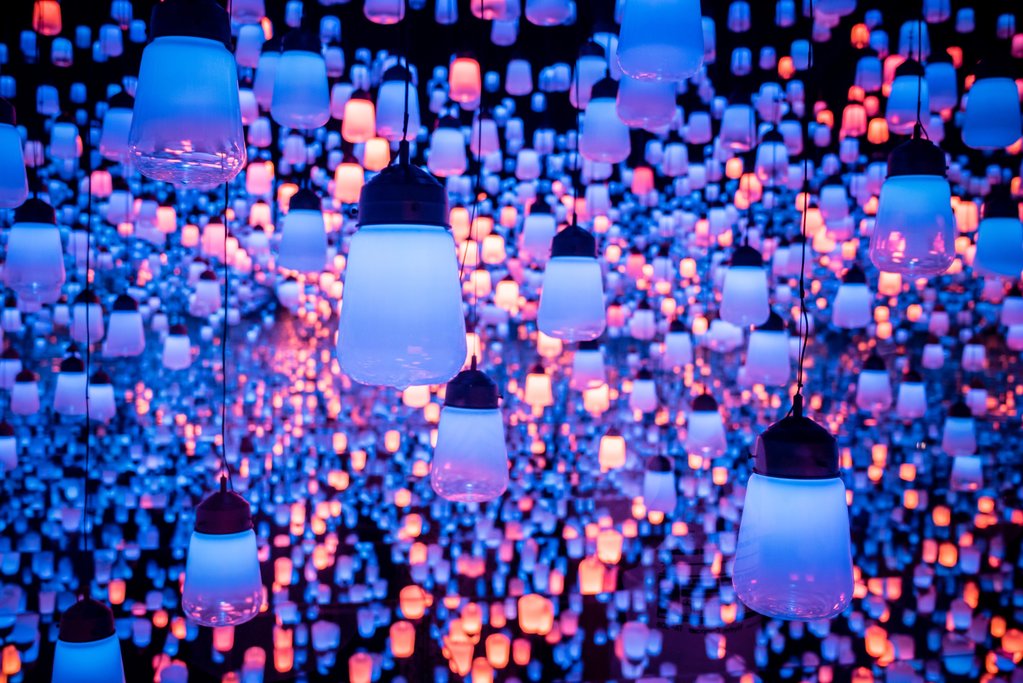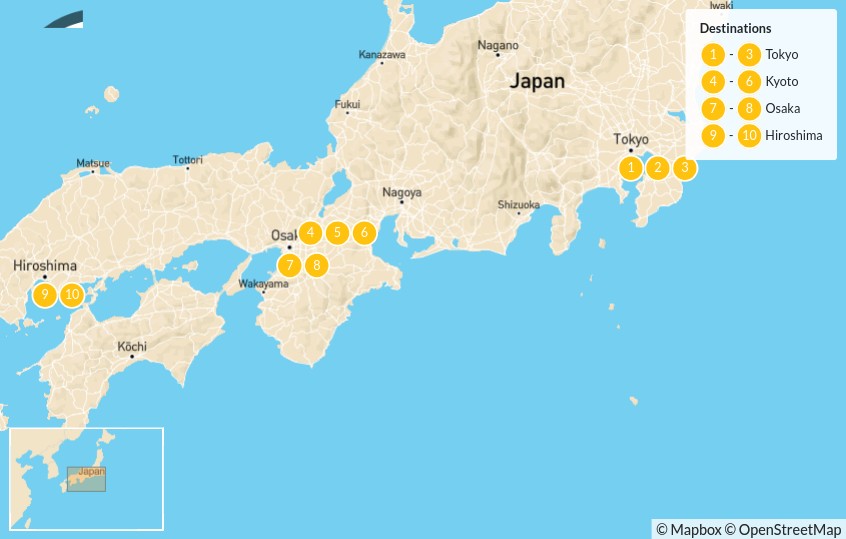Highlights
- Sample sake and sumo wrestling in Tokyo
- Step back in time with a traditional boat ride in Kyoto
- Savor traditional street food in Osaka
- Discover the rebirth of vibrant Hiroshima
- Explore the pristine, deer-filled island of Miyajima
Brief Itinerary
| Day | Highlights | Overnight |
|---|---|---|
| Day 1 | Welcome to Tokyo! | Tokyo |
| Day 2 | See Sumo & Taste Sake in Tokyo | Tokyo |
| Day 3 | Explore Futuristic Odaiba | Tokyo |
| Day 4 | Discover Geisha Culture in Kyoto | Kyoto |
| Day 5 | Enjoy Bamboo Groves & Temples in Arashiyama | Kyoto |
| Day 6 | Day-trip to Nara | Kyoto |
| Day 7 | Sample Kansai Cuisine in Osaka | Osaka |
| Day 8 | Sightsee in Osaka | Osaka |
| Day 9 | Visit the Peace Memorial Park in Hiroshima | Hiroshima |
| Day 10 | Depart Japan |
Detailed Itinerary
Day 1: Welcome to Tokyo!

Welcome to Japan! Get oriented in Tokyo with a visit to the world’s tallest tower. At 2,080 feet (634 meters), the Tokyo Skytree offers spectacular views as far as Mount Fuji from its 360-degree observation deck. Afterward, take a walk through the grounds of Sensoji, the city's oldest and most historically significant temple. Legends say it was founded when two brothers fished a statue of the goddess Kannon out of the Sumida River. The neighboring Asakusa Shrine also highlights the stark differences between Shinto and Buddhist belief systems. As night falls, make your way to Shibuya, home to the vibrant Shibuya Crossing. The area is packed with restaurants, bars, and nightclubs, perfect for a night out on the town.
Day 2: See Sumo & Taste Sake in Tokyo

Today you'll get a deeper insight into some traditional and spiritual aspects of Japanese culture. Begin by heading to a morning sumo training session in Ryogoku, where you'll witness the skill and power of these traditional athletes. More ceremony than sport, sumo wrestling is a tradition that began centuries ago — as the legend goes, it started as a ritual to entertain the gods.
Afterward, take a short walk to the Edo-Tokyo Museum to discover what it was like to live in 16th-century Japan. Learn about how the residents worked together to build and protect their communities while walking through the halls of a replica Edo-era town. End the afternoon with a visit to one of Tokyo’s sake tasting centers. Choose from a sampling of over 80 different fermented wines and spirits as you learn the art of food and sake pairing.
Day 3: Explore Futuristic Odaiba

Today you'll explore the artificial island of Odaiba, a hot spot for futuristic fun. The trip to this shopping and entertainment district is enjoyable, whether you arrive by taking a cruise through Tokyo Bay or by crossing the colorful Rainbow Bridge. Start at TeamLab, a permanent interactive art exhibition on the island that gives new meaning to the term "modern art" — be prepared to follow art as it moves along the walls. Car enthusiasts can also visit the nearby Toyota City Showcase. Check out the latest innovations in the technology zone, reminisce about the old days in the vintage car collection rooms, or test-drive a favorite car on their private track (an international driving license is required).
In the evening, experience one of Tokyo's wackiest shows at the Robot Restaurant. Less of a culinary adventure and more of a theatrical experience, this 90-minute show is jam-packed with neon lights and vibrant music and is a great way to experience Japan's techno culture. Afterward, weave in and out of the alleys of the famous Golden Gai district, stopping in some of the area's hundreds of bars.
Chat with a local specialist who can help organize your trip.
Day 4: Discover Geisha Culture in Kyoto

Transfer today to Kyoto, the former capital of Japan. Overflowing with history and a lot more traditional than its Tokyo counterpart, things here move at a slower pace and the people tend to be more laid-back. While here, a visit to what is arguably the most famous shrine in Japan – Fushimi Inari – is an absolute must. Featured in the movie Memoirs of a Geisha, this shrine has more than 10,000 picturesque red torii gates. They were all donated by Japanese individuals and businesses as a sign of appreciation to the god Inari for blessings received.
Your visit to Inari perfectly sets the tone for your next stop: a traditional Japanese arts show. As well as offering a chance to see a performance by a maiko (geisha in training), this hourlong theatrical experience also introduces you to various skilled artists, including ikebana (flower arrangers), puppeteers, koto (Japanese harp players), and court musicians. In the evening, talk a walk through the bustling streets of Pontocho. Right next to the Kamogawa River, this area is home to a wide range of restaurants and bars. If you prefer, you can also request a private dinner or tea ceremony with a geisha.
Day 5: Enjoy Bamboo Groves & Temples in Arashiyama

Just outside Kyoto is the tranquil area of Arashiyama. You will start your day with a ride on an open-air train that offers amazing views of the river and the surrounding forest. (Note: This train does not operate in the winter months.) You’ll then travel down the Hozugawa River on a traditional Japanese boat. This activity is often the highlight of the trip, and depending on the season, you’ll be floating past white and pink cherry blossoms (in March), the deep green leaves of a warm summer (in July), or the brilliant and fiery colors of autumn trees (in November).
Then you will embark on a tour of some of the area's well-known sites. Tenryuji Temple is a UNESCO World Heritage Site and houses one of the most picturesque and ancient landscape gardens in the entire country. Behind it, you will find its world-famous bamboo grove, which transports visitors into another realm — or at least appears to. Also in the area, you will find the Nonomiya shrine and the Iwatayama Monkey Park where macaques roam freely. If you're up for a walk, there's a lovely temple that houses hundreds of statues. If you look closely, you'll find some of these Buddhist statues sporting glasses and carrying cellphones, a reflection of how modern life has also affected spiritual practices.
Day 6: Day-trip to Nara

Today you'll side-trip to the city of Nara, famous for its traditional sites and resident herds of peaceful deer. With scenic gardens, parks, temples, and shrines, it's a quiet place that you'll enjoy exploring at your own pace. Nara also has some stunning walking trails, one of which will take you through the Mount Kasuga Primeval Forest. The Todaiji Temple, home to the giant Daibutsu Buddha statue, is a must-see before you head back to Kyoto for the evening.
Days 7: Sample Kansai Cuisine in Osaka

After breakfast, move on to Osaka. The city gives Tokyo a run for its money when it comes to delicious cuisine. Today you'll experience its delights with a street food tour. Enjoy being tantalized with mouthwatering smells and tastes as you traverse the city streets, sampling the specialties of the Kansai area. Savor the best rice wine in the region at a nearby sake brewery, then tour and taste at the nearby whiskey distillery. Finish your adventure in the trendy Dotonbori district. Full of fantastic restaurants, clubs, and karaoke bars, it's the city's go-to area for a lively night out.
Day 8: Sightsee in Osaka

You'll have the day to explore the city at your own pace. The superb Osaka Castle is a must-see, along with Shitennoji Temple, a center of spiritual life for the people of Osaka. But the city's modern attractions are just as worthwhile, including bustling markets, the colorful district of Dotombori, the landmark Tsutenkaku Tower, the futuristic aquarium, and Abeno Harukas, currently the tallest building in Japan. Foodies won't want to miss a visit to the Cup Noodles Museum Osaka Ikeda, dedicated to the art of instant ramen. Go out for modern or traditional Japanese cuisine in the evening before resting at your hotel in Osaka.
Day 9: Visit the Peace Memorial Park in Hiroshima

The itinerary takes you to Hiroshima on day nine, a modern city of wide boulevards, flowing rivers, and a lively downtown. Of course, it's a tragic legacy that sets this city apart: Hiroshima was the world’s first city destroyed by an atomic bomb during World War II. (The second was Nagasaki.) You'll learn about this 1945 event at the Peace Memorial Park, which features the ruins of Genbaku Dome, one of the only buildings that was left standing after the blast. Stroll through Shukkei-en, a Japanese garden, and stop by the beautifully landscaped fortress of Hiroshima Castle. Then go out for Japanese food in the city center before heading to your hotel. One regional dish to look for is okonomiyaki, a savory pancake topped with shredded cabbage, noodles, and pork belly.
Day 10: Depart Hiroshima

It's time to depart Japan! Today, if time allows, you can visit the island of Miyajima. On the short ferry ride there, be sure to stand on the deck to get a good view of the giant red torii gate rising out of the sea. Miyajima holds the rare distinction in Japan of having never experienced an earthquake. Because of this, many of its temples are entirely original and centuries old.
Be sure to visit Daisho Temple, Itsukushima Shrine, and Mount Misen. The view from the top of the mountain is superb, looking out across the inland sea. The island is also populated with friendly deer, which only adds to the fairytale-like setting. Later you'll transfer to one of the region's airports to catch a flight out. Safe travels!
More Japan Itineraries
Looking for more inspiration for your trip to Japan? Check out these other Japan itineraries, with walking tours, cultural journeys, and best-of trips to hit the highlights.
Or, describe your ideal trip and we will connect you with a local specialist to make it happen.


